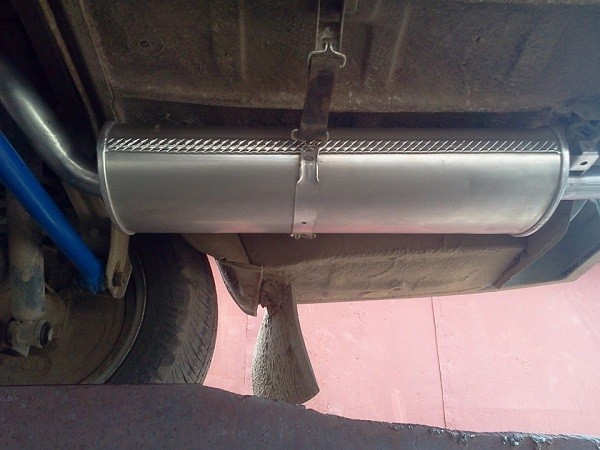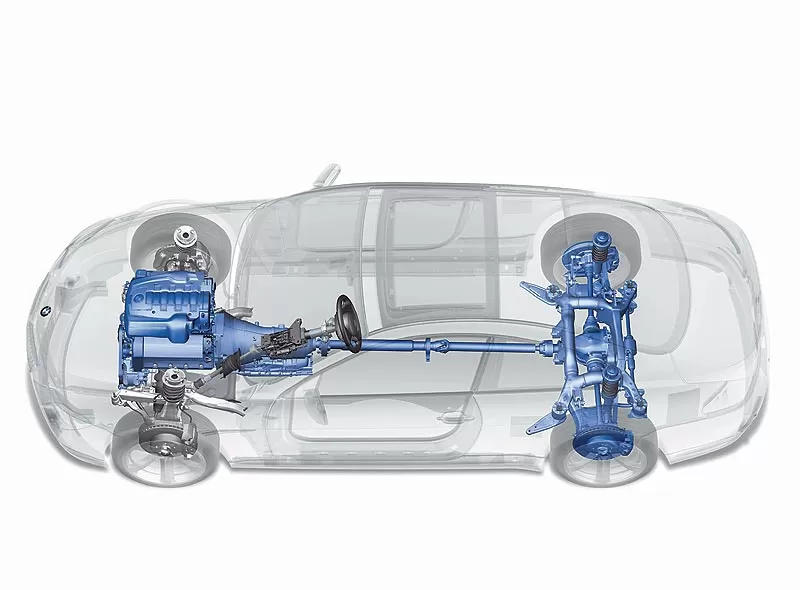
Do-It-Yourself Exhaust Pipe Replacement - Loud noises require immediate action!
Content
If the car gets noisy and the driving experience stays the same, it is often the exhaust that is the problem. Thanks to its simple design, mostly cheap materials and easy installation, its replacement is not a problem even for non-specialists. Read here what to look for when replacing an exhaust.
The exhaust is one of the busiest parts of a car and is designed as a wear part so as not to make the car too expensive. This means that the exhaust has a limited lifespan.
Exhaust gas flow line

On the way to the open air, the exhaust gases pass through the following stations:
- an exhaust manifold
- Y-pipe
- flexible pipe
- catalytic converter
- central pipe
- middle muffler
- end silencer
- tail section

Each combustion in the engine produces exhaust gases passing through the exhaust valve past the manifold gasket into the manifold. The collector is a curved pipe that directs the hot stream along the bottom of the car. The manifold is attached to the engine and is therefore highly susceptible to vibration.It is a particularly heavy and massive cast steel component. . The manifold usually lasts the lifetime of the vehicle. In the event of a serious imbalance in the engine, it may crack. This is one of the most expensive exhaust system components, although it can be installed as a used part. However, there is no rule without exception: in some vehicles, the catalytic converter is built into the manifold .

- Manifold-connected Y-pipe combines the exhaust gas flow from the individual combustion chambers into a single channel . This component is also quite massive. The lambda probe is built into the manifold. Its task is to measure the residual oxygen in the exhaust gas stream and transmit this data to the control unit. The Y-pipe can also be installed as a used part.

- Y-tube is followed by a short flexible tube . Measuring just a few inches, this component is the exact opposite of the heavy and massive cast steel header and Y-pipe when it comes to construction. Consisting of stainless steel fabric, it is very flexible and can move easily in all directions. There is a good reason for this: the flexible tube absorbs strong vibrations from the engine, preventing them from affecting downstream components.

- The flexible pipe is followed by a catalytic converter . This component cleans the exhaust. It is very important that this component is not affected by engine vibrations. Otherwise, its ceramic internal component will break.

- After the catalytic converter comes the real exhaust pipe , which is often equipped with a middle muffler. Since 2014, another sensor has been installed as standard in the central pipe to measure the performance of the catalyst. This sensor is called a diagnostic sensor.

- End silencer connected to center pipe . This is where the real noise cancellation comes in. The end silencer ends with the tail section. The entire exhaust is attached to the bottom of the car with simple but very massive rubber bands. They hold the pipeline at an equal distance from the bottom of the car. At the same time, they allow swinging, preventing bending of the rigid pipe.
Weak spots in the exhaust
- The most stressed exhaust component is the flexible pipe . It must withstand sudden changes in temperature and constantly shrink. However, this €15 (±£13) component is surprisingly durable. If cracks appear on it, this is immediately noticed, as the engine makes a deafening noise. With a cracked flexible pipe, even a 45-horsepower car soon sounds like a Formula 1 racing car .
- The end silencer is most prone to defects . This component consists of a thin galvanized steel sheet. It is not only subject to sudden changes in temperature. During the cooling phase, the exhaust attracts condensate .In the end silencer, moisture mixes with exhaust soot, forming a slightly acidic liquid that corrodes the exhaust pipe from the inside. On the other hand, rust caused by road salt eats away at the end muffler lining. Thus, the end muffler only lasts a few years. A faulty end silencer is identified by a gradual increase in engine noise. When visually inspecting the part, black smudges can be found. These are the places where the exhaust gas exits, leaving a trail of soot.
- The catalytic converter reports its malfunction with rattling and knocking, which indicates a breakdown of the ceramic core . Pieces roll around the hull . Sooner or later the noises will stop - the case is empty. The entire core crumbled into dust and is blown out by the flow of exhaust gases.Ultimately, the next inspection will show this: a car without a catalytic converter will fail the emissions test . With the help of newly installed standard diagnostic sensors, this defect is noticed much earlier.
Don't be afraid of a faulty exhaust

The exhaust is one of the easiest parts to repair. . However, prices for individual components vary greatly. The most expensive part is the catalytic converter, which can cost more than 1000 euros (± 900 pounds) .
You can try replacing it with a used part, however you never know if a used catalytic converter is working properly.
Flexible pipe, middle muffler and end muffler are much cheaper and can be purchased separately. In particular, the end silencer, depending on the quality and driving style, may “burst” after a few years. In most cases this is not a problem at all.
New end silencer for most car series cost less than 100 euros (± 90 pounds) . The same applies to the middle muffler. The middle tube is surprisingly strong in most vehicles. Although it does not last as long as a manifold or Y-tube, it is not a wear part.
Exhaust system repair

In a technical sense, the exhaust consists of a set of connected pipes held together with clamps. . Theoretically, they can be easily separated. In practice, rust and dirt often cause pipes to stick together. Before drawing blood from your fingers, it is best to use an angle grinder. Always make sure that sparks do not fly from the vehicle. Ideally, the bottom is covered when grinding the old exhaust. However, be very careful: sparks are a high fire hazard!
If sanding cannot be avoided, always work smart: remove only the defective part. The whole part must remain intact. It makes no sense to cut the catalytic converter to remove the flexible tube. Instead, the remaining piece can be removed from the old part with a screwdriver and a couple of hammer blows.
Welding is useless
There is no point in welding the exhaust pipe . Even in new condition, the metal is so thin that it is difficult to weld. If the end silencer is full of holes, there is practically no sufficiently strong skin left. Complete muffler replacement is faster, cleaner and more durable than welding.
Complete replacement is the easiest way
As an alternative to replacing individual faulty components, replacing the entire exhaust is obvious. "All" means everything except the catalytic converter, including the flexible pipe.
Dismantling and removal of the old pipeline is much easier. In addition, a completely new exhaust ensures maximum safety and service life. An equal load on all components leads to their simultaneous wear.
If the flexible pipe breaks, corrosion of the end silencer will soon follow. Low prices for complete exhaust systems (without catalytic converter) make the complete replacement of all wearing parts particularly easy. Replacing an exhaust always involves replacing rubber bands. Exhaust foam rubber will be criticized during technical inspection.
This can be avoided at little cost. Complete exhaust systems without catalytic converter available less than 100 euros depending on the car model.

